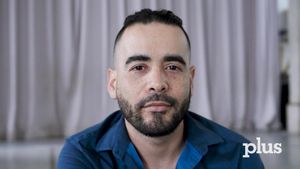The aggressive
antibiotic-resistant staph infection responsible for
thousands of recent illnesses undermines the body's defenses
by causing germ-fighting cells to explode, researchers
reported Sunday. Experts say the findings may help
lead to better treatments.
An estimated
90,000 people in the United States fall ill each year from
methicillin-resistant Staphylococcus aureus, or MRSA.
It is not clear how many die from the infection; one
estimate put it at more than 18,000, which would be
slightly higher than U.S. deaths from AIDS.
The infection
long has been associated with health care facilities, where
it attacks people with reduced immune systems. But many
recent cases involve an aggressive strain,
community-associated MRSA, or CA-MRSA. It can cause
severe infections and even death in otherwise healthy people
outside of health care settings. While only 14% of serious
MRSA infections are the community-associated kind,
they have drawn attention in recent months with a
spate of reports in schools, including the death of a
17-year-old Virginia high school student.
A recent study
of CA-MRSA was conducted by a team of U.S. and
German researchers led by Michael Otto of the National
Institute of Allergy and Infectious Diseases. The
study's findings appeared in Sunday's online edition
of the journal Nature Medicine. The study was
conducted in mice and with human blood in laboratory
tests.
The researchers
found that the CA-MRSA strain secretes a kind of
peptide -- a compound formed by amino acids -- that
causes immune cells called neutrophils to burst,
eliminating a main defense against infection. Both
hospital-associated and community-associated MRSA
contained genes for the peptides. But their production was
much higher in the CA-MRSA, the researchers said. The
compounds first cause inflammation, drawing the immune
cells to the site of the infection, and then destroy
those cells.
Within five
minutes of exposure to the peptides from CA-MRSA, human
neutrophils showed flattening and signs of damage to their
membrane, researchers said. After 60 minutes, many
cells had disintegrated completely.
''This elegant
work helps reveal the complex strategy that S.
aureus has developed to evade our normal immune
defenses,'' Anthony S. Fauci, NIAID director, said in
a statement. ''Understanding what makes the infections
caused by these new strains so severe and developing new
drugs to treat them are urgent public health priorities.''
George Zhanel, a
medical microbiologist at the University of Manitoba in
Canada, said the study was the first he had seen that
identifies the peptides involved. It showed at least
one of the reasons CA-MRSA is able to cause serious
problems, Zhanel, who was not part of the research team,
said in a telephone interview. Findings like this may help
lead to better treatments, such as ways to neutralize
the peptides or to activate the immune system to
defeat them, he added.
Lindsey Shaw, of
the division of cell biology, microbiology, and
molecular biology at the University of South Florida, also
was enthusiastic about the research. ''Specifically
identifying a factor which seemingly makes CA-MRSA
more pathogenic than HA-MRSA is a real find,'' Shaw,
who was not part of the research group, said via e-mail.
The ''molecules identified in the study are indeed novel.''
Zhanel noted that
while hospital-based MRSA seemed to concentrate on
''sick old people,'' the community-based strain can break
out in on sports teams, prisons, cruise ships, and
other places where people are not necessarily sick or
have weakened immune systems. He also noted the
worrisome development of more aggressive strains that have
started appearing in hospitals.
Clarence Creech,
an assistant professor of pediatric infectious disease
at Vanderbilt University, said every time scientists find a
new way that staph uses to make people sick, ''we open
up the field of developing new vaccine targets and new
drug targets.''
''This is one of
the papers we can look to as we develop new vaccines and
drugs,'' Creech, who was not part of the research team, said
in a telephone interview.
The research was
funded by the National Institutes of Health, the German
Research Council, and the German Ministry of Education and
Research. (AP)
































































Charlie Kirk DID say stoning gay people was the 'perfect law' — and these other heinous quotes